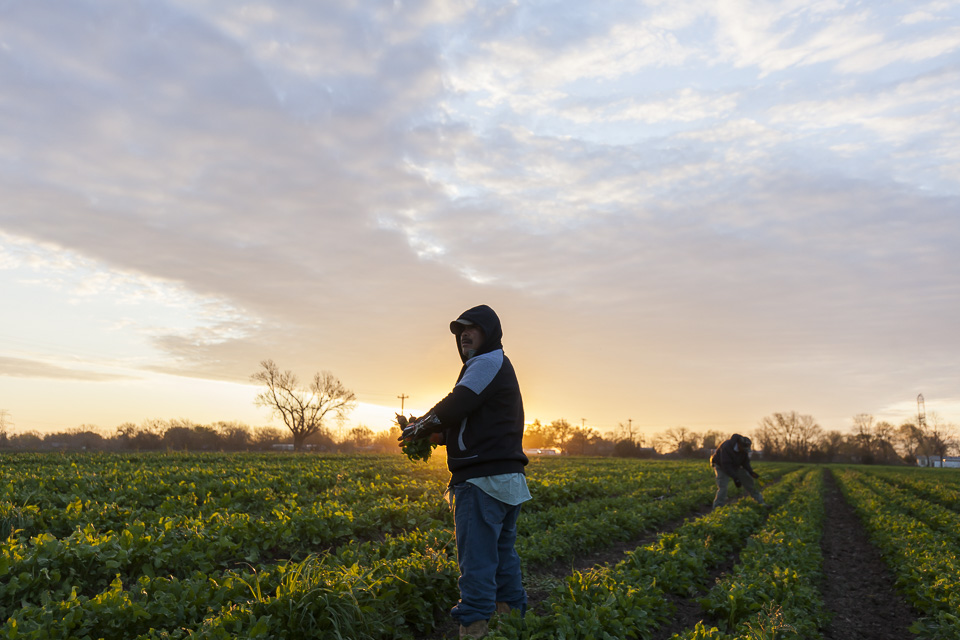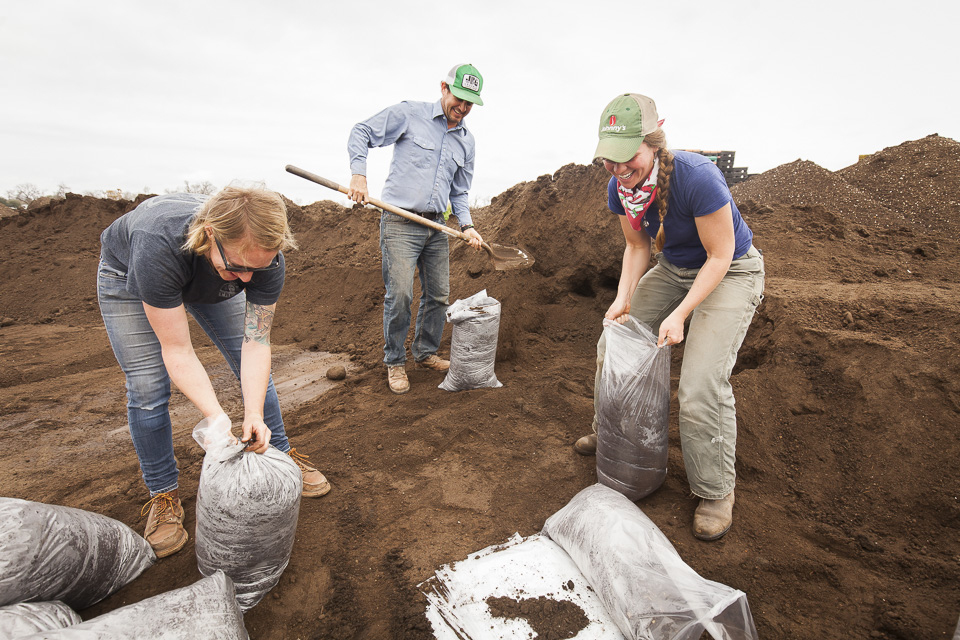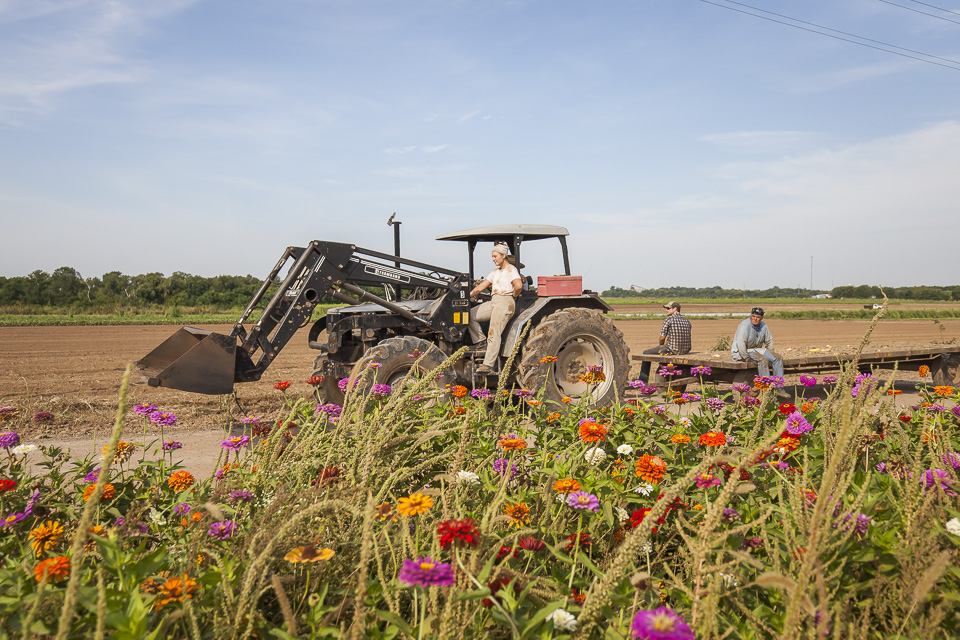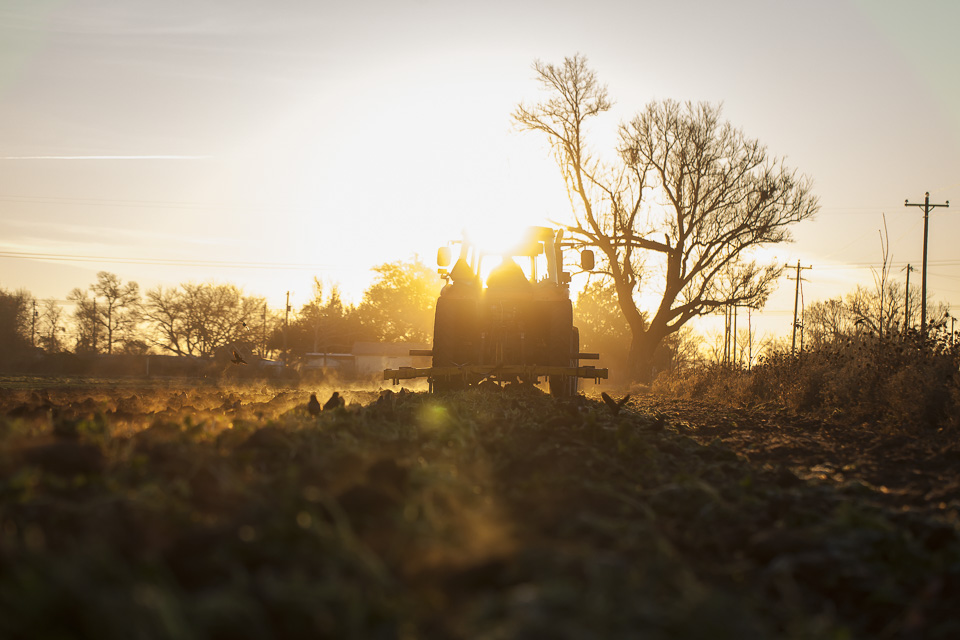
WHAT DOES IT MEAN TO BE CERTIFIED ORGANIC?
01/18/19 — Heydon Hatcher
As we hurtle towards spring at the farm, busily trying to finalize crop plans, purchase seeds, and get the fields prepared, we are also celebrating finalizing our organic re-certification! (That’s right, all of the veggies in your CSA box are certified 100% organic… sign up now and get your first box free! Just enter “VEGGIEHEAVEN” when you sign up.) We go through the rigorous organic certification process annually, and this year, we thought it would be a good opportunity to tell the JBG community a little bit more about our growing practices at the farm. "Organic" can manifest itself in a number of different ways and we’re thrilled by what we've accomplished here. We also realized that you folks might not know what an organic certification looks like and wanted to let you in on the process.
![]() Early morning harvest. Photo by Scott David Gordon.
Early morning harvest. Photo by Scott David Gordon.
When Brenton first started in the backyard garden, he knew each and every one of his customers and didn't need a USDA seal to tell them about his growing practices. When he became a full-time farmer in 2008, he made the decision to undergo JBG’s first official organic certification, and man, are we glad he made that decision early on! The biggest lesson we’ve all learned is that organic certification requires some meticulous record-keeping - tracking all of our crops from seed to sale. Now that we're on 200 acres, that record keeping has gotten extremely complex, so we’re grateful that our organic certification required us to develop our record-keeping systems early on.
We are certified organic by Nature's International Certification Services (NICS), based out of Wisconsin. When our certifier comes for their annual farm inspection, they take a grand tour of JBG. This includes a field walk, facilities inspections, a look into where we store seeds, tools, amendments, soils, etc., and a sit-down interview where we review our 5-year Organic System Plan (OSP), our records from the previous year and plans for the coming one. We'll walk through an audit of a crop or multiple crops, tracking the vegetable from the purchase of organic seeds, through our greenhouse and planting in the field, to weeding and pest management, to harvest and finally to the customer. Wow! We go into the details of everything from our buffer zones around the farm, to logo colors and placement on our CSA boxes. It's an extremely long and detailed process, but thanks to a hard-working staff we know that we have all of our ducks in a row. For the large part though, the certification looks at the following areas of our production system, with a few details on how we do it at JBG:
![]() Compost fun. Photo by Scott David Gordon.
Compost fun. Photo by Scott David Gordon.
![]() Farm flowers. Photo by Scott David Gordon.
Farm flowers. Photo by Scott David Gordon.
![]() Happy trails! Photo by Scott David Gordon.
Happy trails! Photo by Scott David Gordon.
 Early morning harvest. Photo by Scott David Gordon.
Early morning harvest. Photo by Scott David Gordon.
When Brenton first started in the backyard garden, he knew each and every one of his customers and didn't need a USDA seal to tell them about his growing practices. When he became a full-time farmer in 2008, he made the decision to undergo JBG’s first official organic certification, and man, are we glad he made that decision early on! The biggest lesson we’ve all learned is that organic certification requires some meticulous record-keeping - tracking all of our crops from seed to sale. Now that we're on 200 acres, that record keeping has gotten extremely complex, so we’re grateful that our organic certification required us to develop our record-keeping systems early on.
We are certified organic by Nature's International Certification Services (NICS), based out of Wisconsin. When our certifier comes for their annual farm inspection, they take a grand tour of JBG. This includes a field walk, facilities inspections, a look into where we store seeds, tools, amendments, soils, etc., and a sit-down interview where we review our 5-year Organic System Plan (OSP), our records from the previous year and plans for the coming one. We'll walk through an audit of a crop or multiple crops, tracking the vegetable from the purchase of organic seeds, through our greenhouse and planting in the field, to weeding and pest management, to harvest and finally to the customer. Wow! We go into the details of everything from our buffer zones around the farm, to logo colors and placement on our CSA boxes. It's an extremely long and detailed process, but thanks to a hard-working staff we know that we have all of our ducks in a row. For the large part though, the certification looks at the following areas of our production system, with a few details on how we do it at JBG:
1. Long-Term Soil Fertility through Ecological Methods
When we grow nutrient-rich food for you and your families, we're pulling a lot of organic matter and nutrients out of our soil! As organic producers, we don't use synthetic fertilizers on the farm, which can cause unintended ecological harm, but rather use natural materials and grow our own fertility:- Crop Rotation. Different types of vegetables take different nutrients from the soil. Our kale will tackle your vitamins A and K requirements, while tomatoes have you covered on vitamin C and biotin! We never plant the same crop twice in a row on the same piece of land, but we rotate our crops around the farm to ensure that we don't deplete our soil of any one nutrient.
- Cover Crops. Did you know that you can actually grow your own fertility? As part of our crop rotation system, we include blocks of cover crops, also known as "green manures," to build both soil fertility and microbiology. This mix of grasses and leguminous crops is planted specifically to be turned back into the soil when fully grown, enriching it with organic matter and nitrogen-fixing bacteria from the legumes! Learn more about our specific cover crops here.
- Compost compost compost! We make sure to add a lot of compost back into our soil - we want to make sure our vegetables have everything they need to grow you the healthiest food! In addition to compost, we are also able to add harder-to-find nutrients into our soil by using things like crushed rocks, bones, or feathers (byproducts of the agriculture industry), and marine products that are byproducts of the fishing industry.
 Compost fun. Photo by Scott David Gordon.
Compost fun. Photo by Scott David Gordon.
2. Natural Pest Management
The general idea behind pest management at JBG is that if you have healthy soil and are growing seasonally appropriate crops and varieties, your plants should be healthy and free of pests and disease! This isn't always the case though, and we use an integrated pest management (IPM) system to address our plant health on the farm.- Attract predators. Have you seen our farm flowers yet? In addition to being a beautiful farmer's market buy, our farmscaping efforts attract all kinds of great insects to the farm! In addition to pollinators like honey bees, flowering plants attract ladybugs to combat aphids, syrphid flies to attack thrips, and lacewings for pesky caterpillars! We like to let some of our fennel, parsley and arugula crops go to seed to help feed the good bugs as well. We installed bat houses on the farm in 2015, a unique Austin solution to combating crop-eating bugs!
- Natural compounds. Sometimes, in order to save a crop, we have to attack the pests ourselves. Temo injected a mix of rosemary oil and other natural herbal oils to our drip system to save our potatoes after a cool, damp Spring season years ago. Read more about that here. We use this method of organic-approved compounds as a last resort since we don't want to hurt those beneficial insects as well.
- Physical methods. Our Head Grower, Temo, also came up with the great idea to vacuum bugs off of the crops once! Have we mentioned how great Temo is at his job? Another physical method we use is our crop rotation - by growing a crop in a different area of the farm each year, we try to keep pests from finding it - like a grower's game of hide and seek. Our big plans for the future are to grow alternating years between two different farm locations, both to help break the pest cycle and increase soil fertility. This is also how we manage weeds on the farm -- lots and lots of physical labor. While we do use tractors to help us weed, a large majority is done by hand, by our hard-working field crews!
 Farm flowers. Photo by Scott David Gordon.
Farm flowers. Photo by Scott David Gordon.
3. Biodiversity on the Farm and Surrounding Ecosystem
As a general rule, ecosystems that have more biodiversity - the number of different plants, animals, insects, etc - are inherently more stable and healthy without additional inputs. We strive to achieve this at JBG in a number of ways:- A diverse mix of crops. Did you know that we grew over 250 different varieties of crops last year? While this leads to a lot of record-keeping, it also provides you and your family with a plethora of options in your CSA boxes!
- Farmscaping. Our flowering plants attract a huge variety of beneficial insects and pollinators to the farm, which also helps with pest management!
- Buffer zones and riparian areas. We maintain a 40 ft zone around the entire farm to avoid material drift and to provide habitat for native plants and animals. In addition, we have a buffer around the waterways that run around and through our farm, which are host to a number of birds, bees, animals, reptiles, and more!
 Happy trails! Photo by Scott David Gordon.
Happy trails! Photo by Scott David Gordon.





 0 ITEMS IN CART
0 ITEMS IN CART 

